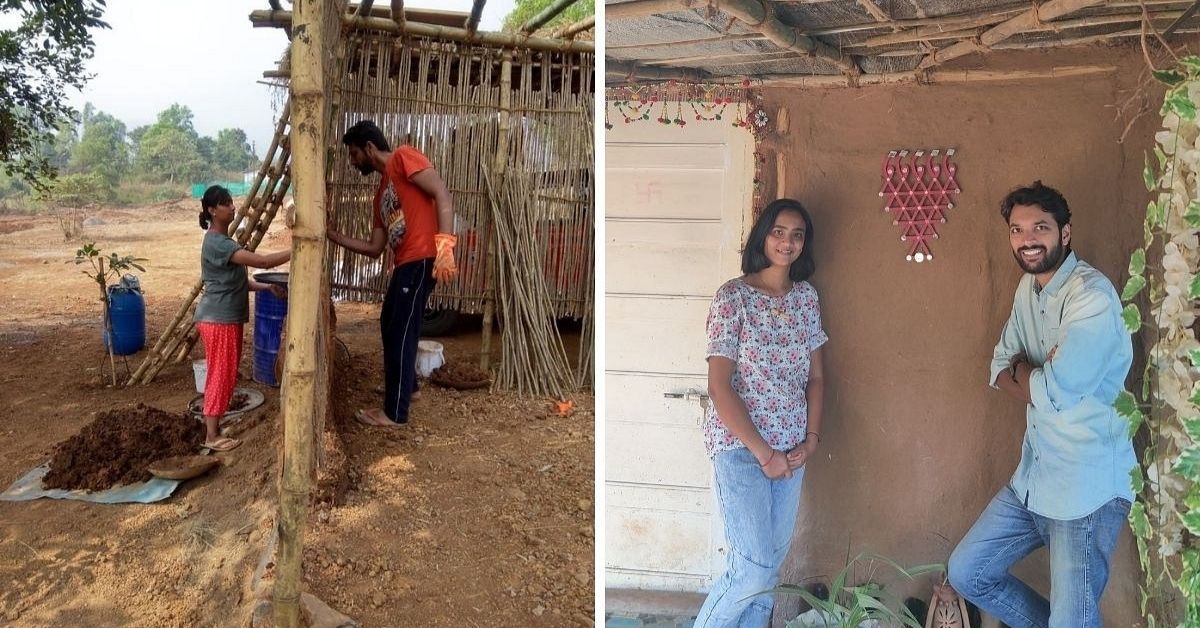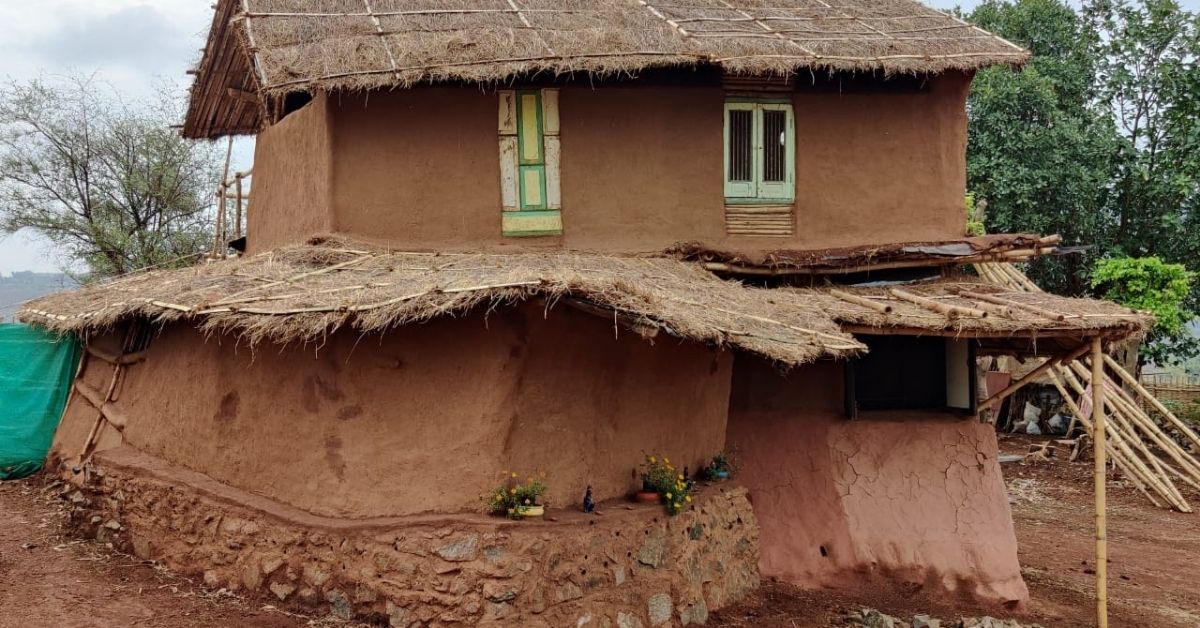Couple Uses 700-YO Method to Build Unique 2-Floor Mud Home In Just Rs 4 Lakh
Yuga Akhare and Sagar Shirude from Pune share how sourcing local materials and labour and upcycling waste helped them build a two-storeyed house for just Rs 4 Lakh.

When Pune-based couple, Yuga Akhare and Sagar Shirude decided to construct a sustainable farmhouse from bamboo and mud, they were advised against it. The villagers of Wagheshwar near Lonavala, Maharashtra, said it would be unwise to build such a house due to the heavy rains and high-wind speeds the village records every year.
But the couple were undeterred and gave them examples of forts that were built using mud centuries ago, which still stand tall in several parts of Maharashtra.
The architect couple went ahead and built a two-storey house using sustainable practices and this year the region experienced the devastating Taukte cyclone.

“The wind speed was around 100 kmph but our house remained as is. There was no damage or dripping rainwater inside the house. A slab on the rooftop was underwater for three days and nothing happened to it,” Yuga tells The Better India.
Their firm ‘Saagaa Associates’ was formed in 2014 after the duo graduated from D Y Patil college in Pune. While they have done several projects, including institutional and residential buildings, this mud house called ‘Mitti Mahal’ (Mud Palace) was a first.
From sourcing, local materials, upcycling to growing organic food, Yuga and Sagar share how they managed to complete the project in just Rs 4 lakh.
Vocal for Local

Since this was fairly new territory for both, they started small and used soil to make the boundary wall.
“As we started to dig the soil to make the wall from stone, we wondered if we could somehow repurpose the soil instead of letting it go to waste. We took empty cement sacks and stuffed them with soil, like the ones that the army uses as bunkers. It worked, and we ended up making 3,500 sacks of bricks and built a wall 3 feet below and 4 feet above ground level,” shares Yuga.
The storeroom was the next step. For this Sagar used mud and bamboo. He had learned this type of construction process during his internship at Mansaram Architects in Bengaluru and a 10-day workshop on mud houses in Thannal, Tamil Nadu.
“We have used locally available bamboo, red soil and grass for this house. We sourced stems of Karvy plants and bamboo mats from a nearby forest for the walls. For clay, we took an indigenous concoction of red soil, husk, jaggery and juice from the myrobalan plant. This was further mixed with neem, cow urine and cow dung. The land preparation and coating for walls were done with cow urine and cow dung,” adds Sagar.

The roofing was done with bamboo frames that were covered with two layers — one of plastic sheets and the other with grass. This layer binding did not allow water inside the house during the monsoons.
The couple recycled wood for windows and doors and upcycled tiles to make bathroom floors.
The house—which was built with local masons over a period of four months—has a verandah, kitchen, living room, bathroom, bedroom and terrace.
A Weatherproof Structure

The couple adopted the ‘wattle and daub’ technique that was invented 700 years ago to make weatherproof structures. In this method, woven lattice of wooden or bamboo strips (wattle) is daubed with a sticky filler material such as mud plaster. It provides high thermal and sound insulation and is lighter in weight.
They have also used a Cob wall system that provides thermoregulation, meaning that they are cool during the summer and absorb heat in the winter. Cob is a mixture of soil, clay, cow dung, hay, cow urine, and lime is kneaded with tools, hands, or feet to make lumps that eventually formed the foundations and walls.
In both the construction methods, the couple has eliminated the need for cement and concrete. Limestone and surkhi (brick dust) came in handy as substitutes for cement.
Due to the adoption of completely eco-friendly measures, the temperature inside this house remains lower than the outside. Sagar said that this year he has spent a summer without AC or fans.

Due to their eco-friendly choices, cost savings was another benefit. By using local labour and materials, transportation costs were eliminated. Additionally, money was saved by replacing cement.
“Our costs came down by almost 70 per cent,” adds Sagar.
Motivated by their green oasis, Yuga and Sagar are now growing organic vegetables in their compound. They are also setting up a greywater recycling system for gardening purposes.
“The septic tank will have seven purification filters such as sand, pebbles, charcoal and aquatic plants. The filtered water will be used for growing organic vegetables,” says Sagar.
They soon hope to open it to tourists who want to experience nature up close. “We have got several queries from our relatives, friends and strangers about stay options, which only shows that people in urban areas are looking for a more sustainable lifestyle, and as architects, we couldn’t be happier,” adds Yuga.
Edited by Yoshita Rao
If you found our stories insightful, informative, or even just enjoyable, we invite you to consider making a voluntary payment to support the work we do at The Better India. Your contribution helps us continue producing quality content that educates, inspires, and drives positive change.
Choose one of the payment options below for your contribution-
By paying for the stories you value, you directly contribute to sustaining our efforts focused on making a difference in the world. Together, let’s ensure that impactful stories continue to be told and shared, enriching lives and communities alike.
Thank you for your support. Here are some frequently asked questions you might find helpful to know why you are contributing?


This story made me
-
97
-
121
-
89
-
167











